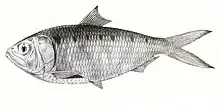Hilsa kelee
Hilsa kelee, called the kelee shad, fivespot herring and the razorbelly, is a species of shad native to the coasts and estuaries of the Indian Ocean and the western Pacific, generally in tropical waters. It feeds on diatoms and dinoflagellates, and any other small plankton that it can trap in its gillrakers. Some individuals can reach 35 cm, but most are around 16.5 cm. Hilsa kelee is currently considered the only species in the genus Hilsa, although other species have been included in the genus previously.
| Kelee shad | |
|---|---|
 | |
| Scientific classification | |
| Kingdom: | |
| Phylum: | |
| Class: | |
| Order: | |
| Family: | |
| Genus: | Hilsa Regan, 1917 |
| Species: | H. kelee |
| Binomial name | |
| Hilsa kelee (Cuvier, 1829) | |
| Synonyms | |
|
Alausa brachysoma Bleeker, 1853 | |
The species is commercially fished, with 221,899 t landed in 2000, and 35,483 t landed in 2008.[1]
References
- "Hilsa kelee". Fisheries Global Information System. Food and Agriculture Organization of the United Nations. Retrieved 23 December 2010.
External links
- Froese, Rainer and Pauly, Daniel, eds. (2010). "Hilsa kelee" in FishBase. October 2010 version.
- "Hilsa kelee". Integrated Taxonomic Information System. Retrieved 23 December 2010.